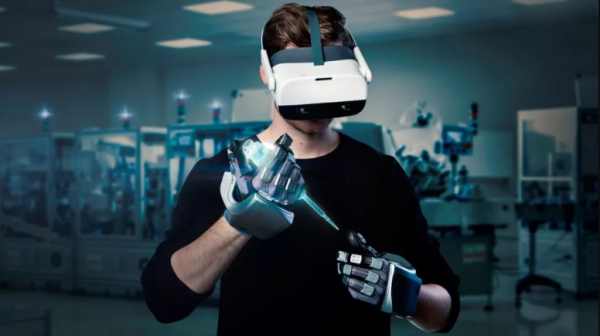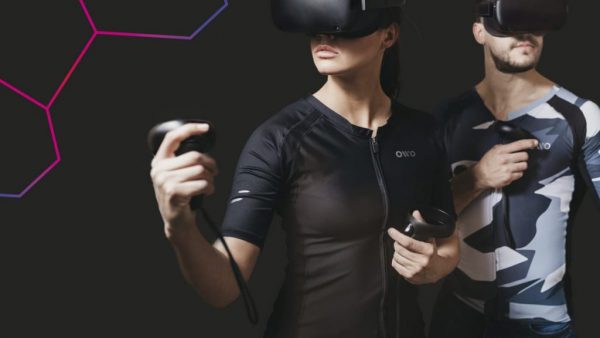Haptics Technology and Why It is Important for the Future of the Metaverse
Haptics is now a common term alongside emerging tech terms like the metaverse. Although research and development work in haptics along with its application in commercial products only exploded in the mid-2010s, the technology has been used, in some form or the other, since the 1980s, primarily in arcade games.
Haptics primarily has got to do with the sense of touch. Haptic technologies create touch simulations between the physical world and the virtual on-screen experiences. Ever since the advent of computing in the 1960s, virtual on-screen experiences have typically been divorced from the real physical world. You can see and hear but you cannot touch or feel it. Haptics break this metaphysical barrier enabling the person partaking in the virtual experiences to feel it, although the current tech still doesn’t allow it to be rendered convincingly.

With the advent of immersive experiences like virtual reality and augmented reality, haptic technologies have become critical in the development of the metaverse. It is haptics that enables immersive experiences to feel more real and engaging.
Haptics has now found broader uses. They are used to create tactile sensations in interfaces. Haptics enables information to be transmitted and understood via the sense of touch.
A haptic experience can be as simple as the vibration in the mobile phone or some rumbling in gaming controllers. However, the forms and utilization of haptic technology have broadened over the years. Haptics is now commonly used in wearables and in AR/VR experiences (or spatial computing). Haptics is also widely applied in automotive infotainment, digital out-of-home advertising, high-end military uses as well as in industrial simulation equipment among others.
Haptics is sometimes referred to as haptic feedback or haptic technology. Haptic technology is generally used to refer to the different kinds of technologies used to simulate tactile sensations while haptic feedback is a term more generally used to refer to how the sense of touch is used to relay information between users.
While these three terms can be used interchangeably, the term haptics is an all-encompassing term used to refer to both haptic technology and haptic feedback. The term haptics is even used to refer to the neuroscience and physiology of touch.
Haptics and the Sense of Touch
Although often relegated beneath other sensations such as vision, hearing, or even smell, the sense of touch is one of the most critical of human sensations. The sense of touch is key to how we understand, explore and interact with our world.
Touch can complement and even substitute our eyes. We can make out the things we don’t see or hear merely by touching them. The sense of touch completes how we experience our world, giving us a richer and more complete field of perception to complement our vision which is high-definition but with a limited field of view. The sense of touch also creates our sense of presence and body ownership and plays a central role in how we communicate our emotions.
Haptics is Coming to the Centerstage
Haptics was pretty much on the periphery as other computing technologies advanced over the past two decades. It is only recently that haptics has come to the fore. Even then, it is still developing on the margins of new technological frontiers such as blockchain, virtual reality, augmented reality, artificial intelligence, and autonomous driving technology among others.
However, that is about to change. In the last few years, haptics has been in step with other developments in computing. The major digital hardware and a host of other startups are now building convincing haptic devices.
The Main Haptic Technologies
Haptic technologies now take various forms. The most commonly deployed type of haptic technology is the tiny motors that generate vibrations in various electronic devices, including mobile phones, wearables, and game controllers.
Another type of haptic technology is microfluidics. There is also friction modulation along with the use of levers and others forms of mechanical devices to generate force feedback. The force feedback is mostly applied on the limbs but there are also full-body haptic devices currently under development.

Most haptic technology, be they haptic vests, haptic suits or haptic gloves require some contact between the user and some surface.
However, contactless haptic technology is also under development. These deliver haptic feedback without controllers or wearables. Contactless haptics relies on lasers or ultrasound to generate tactile sensations mid-air.

Haptic Technology Increasingly Finding Its Way into Applications
In the virtual reality or mixed reality realms, haptics is generally regarded as a peripheral accessory that merely adds to the realism of the immersive experiences. Most VR/XR companies, actually, primarily add haptics to their applications for this purpose.
However, haptics is now being applied to many other applications beyond the mere, almost gimmicky, enhancement of the immersive experience for the user. Interaction design, for instance, involves the incorporation of haptics not only to add to the realism but also to enhance the user experience. Evidence suggests the use of haptics minimizes error rates and completion times. Besides, users are becoming more aware of haptics and are now showing a preference for interfaces that offer this technology.
Haptics is also used as an alternative communication channel whenever the auditory and visual channels are busy. This is key in uses like immersive entertainment and marketing.
Haptic Technology Offers Limitless Possibilities
Tactile feedback offers great new potential in human-machine interactions. As this technology evolves, it provides limitless possibilities. Human beings instinctively understand touch sensations. We can make out most objects by merely touching them. Haptics will play an important role in the future as we immerse ourselves ever deeper into the metaverse.
https://virtualrealitytimes.com/2022/12/19/haptics-technology-and-why-it-is-important-for-the-future-of-the-metaverse/https://virtualrealitytimes.com/wp-content/uploads/2021/11/Meta-Haptic-Glove-600x401.pnghttps://virtualrealitytimes.com/wp-content/uploads/2021/11/Meta-Haptic-Glove-150x90.pngComputingHapticsHardwareTechnologyHaptics is now a common term alongside emerging tech terms like the metaverse. Although research and development work in haptics along with its application in commercial products only exploded in the mid-2010s, the technology has been used, in some form or the other, since the 1980s, primarily in arcade...Rob GrantRob Grant[email protected]AuthorVirtual Reality Times - Metaverse & VR
